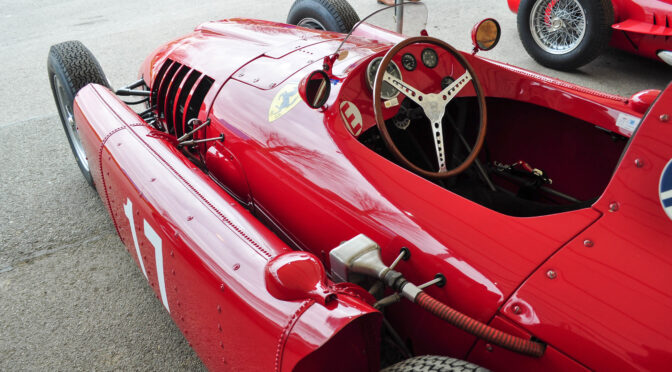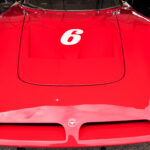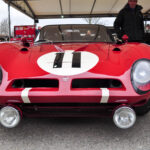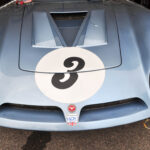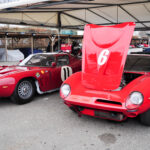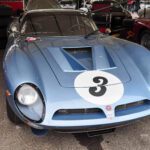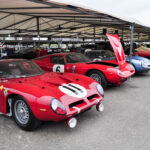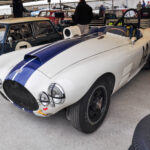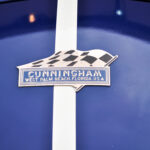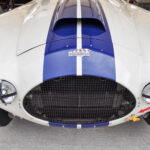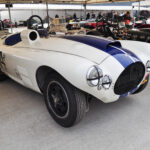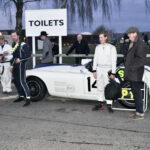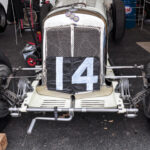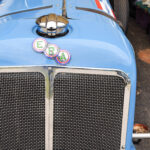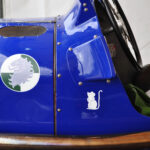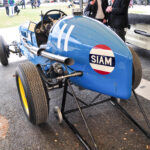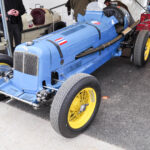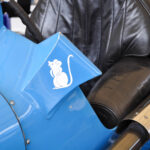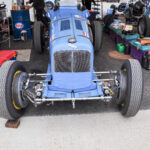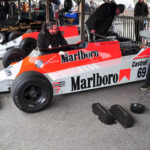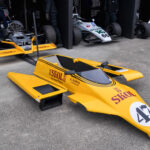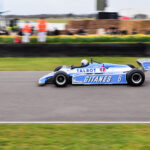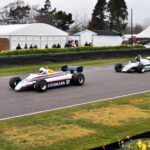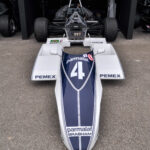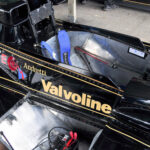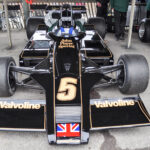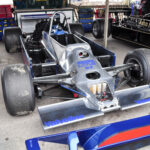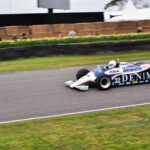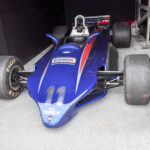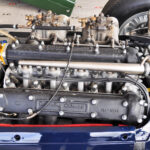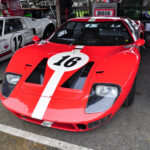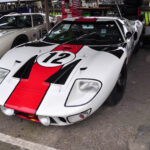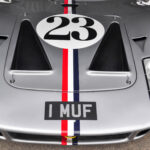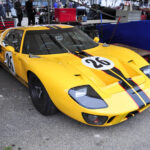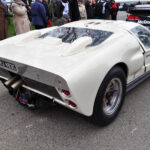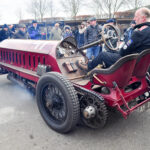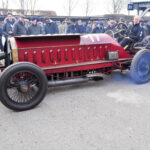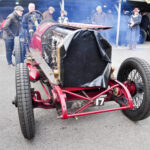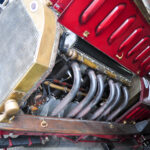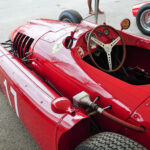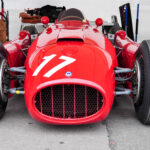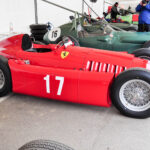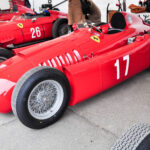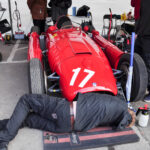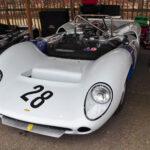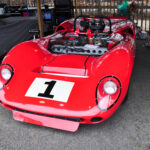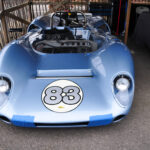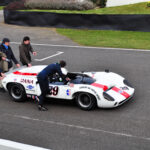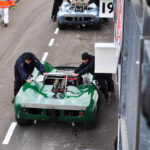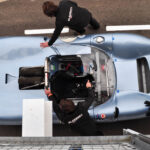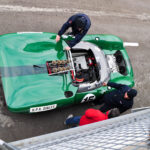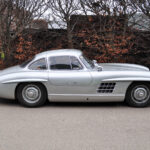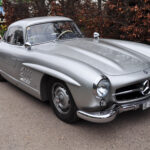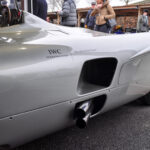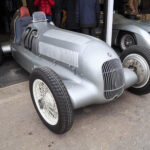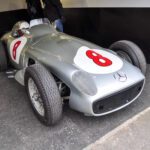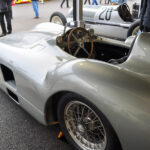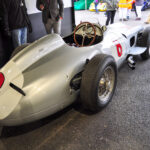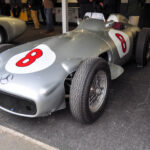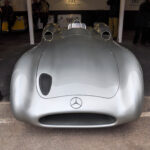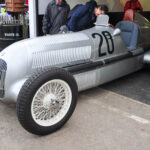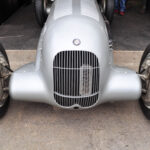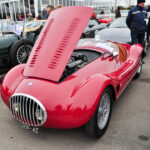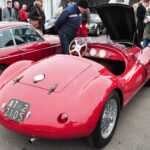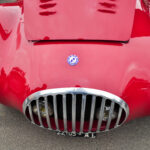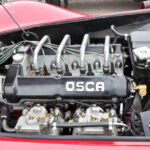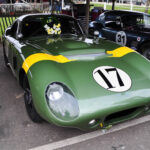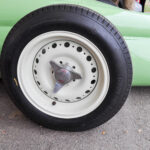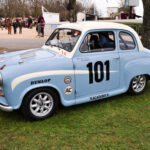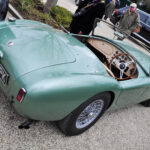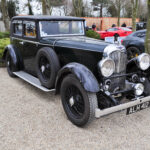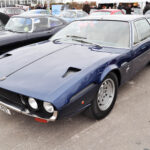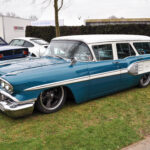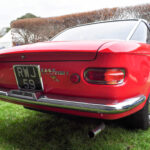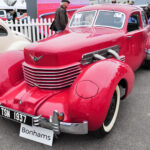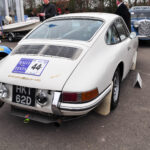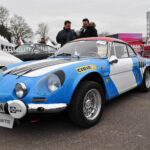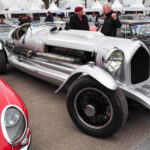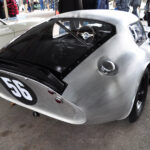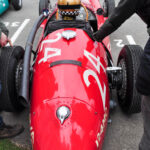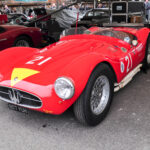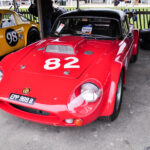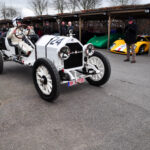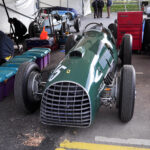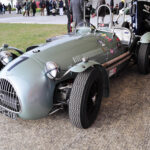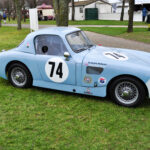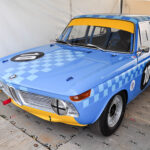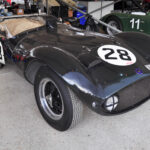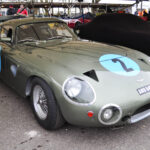The Perils of High Speed Circuits.
As Goodwood circuit is not used all year round due to local noise restrictions – it’s easy to forget that it’s is a very high speed circuit and therein lies the risk to race drivers and to spectators.
At the end of the first lap of the first of Sunday’s races a really scary crash unfolded right in front of me on the start/finish straight when Richard Wilson’s Lotus Cooper Climax T51 collided with Stephen Bond’s Lotus Climax 18.
Instead of both cars coming to rest on the track or in the tyre wall – the collision caused Bond’s Lotus to go into an end-over-end cartwheel which lifted it over the wall and hedge of an access road before it plummeted down into a pedestrian tunnel right next to the viewing area for wheelchair users.
Possibly because it was early in the day – the pedestrian tunnel was empty so by a miracle spectator injuries were avoided. Stephen Bond also came out of it with broken ribs but was extremely lucky not to come out worse particularly as fuel was pouring from the car as he hung suspended in his seat belts.
It’s horrible to contemplate but with slightly more forward momentum the cartwheeling car could easily have cleared the pedestrian tunnel and landed on the wheelchair spectator viewing area.
Luck was with a number of people as it looked like the accident could have shaped up to be a 1955 Le Mans type incident.
I was rooted to the spot watching the accident in slow motion but a few yards further along the viewing platform Tim Quinlan captured this remarkable footage of the accident:-
https://www.youtube.com/watch?v=021GVfHJ_YE&feature=youtu.be&app=desktop
Back To The Event
Part 1 concentrated on the Group 5 cars at the 74th Members Meeting so Part 2 looks at other interesting groups of cars and individual cars inside, on and around the Goodwood circuit:-
Bizzarrini 5300 GT Strada (& Iso Grifo A3/Corsa)
I’m a big fan of Giotto Bizzarrini the designer and especially of his Bizzarrini 5300 GT Strada.
His previous masterpieces included the Ferrari 250 GT, Ferrari Testa Rossa, Ferrari GTO, Ferrari “Breadvan”, Lamborghini V12 engine, Iso Rivolta and Iso Grifo. His main passion however was to create out and out racing GT sports cars bearing his own name as epitomised by the Bizzarrini 5300 GT Strada.
Parting company with Iso, Bizzarrini took the design of the Iso Grifo A3 Corsa back to his home town of Livorno to re-badge it as the Bizzarrini 5300 GT Strada.
This small bunch of Iso/Bizzarrini race cars at Goodwood was great to see. Raised bonnets provided a great opportunity Bizzarrini’s trademark ploy of positioning the engine so far back in the chassis to imrove fore & aft weight distribution that it almost made the car mid-engine. With a tuned Corvette engine in a lightweight body/chassis package – these cars must be great fun to drive.
Cunningham C4-R
This Cunningham C4-R quite literally lit up the track in the last race of the day as dusk decended over Goodwood.
From the start of the race – the C4-R shot off into the distance with its Cadillac V8 engine roaring and nothing could catch it. By the end of the race it was already starting to lap the back markers so this was a real testament to the preparation of the car and to the skills of its driver.
Cunningham cars are rare sight on British classic car race grids so it was really nice to see this C4-R doing what it was designed to do.
The car was designed and raced in the 1950s by Briggs Cunningham, a wealthy American entrepreneur who was able to indulge his interest in racing boats and cars.
Cunningham started off modifying cars to be raced by himself and others by mixing and matching chassis and engines to maximise performance. In 1950 he entered two modified Cadillacs in a bid to win the Le Mans 24 hour race for America. One of these cars with heavily modified (and decidedly un-pretty bodywork) was famously referred to as “Le Monstre” by the Le Mans crowd.
Eventually Cunningham opted to build his own cars starting with the Cunningham C3 – a road car which featured a Vignale manufactured steel & alloy body and a Chrysler hemi-V8 engine.
Racing versions followed in the form of the C2-R, C4-R, C5-R and C6-R using Cadillac and Offenhauser engines as Cunningham launched an all-American assault on races at home (winning the 1953 Sebring 12 hour race in a C4-R) and abroad (most especially Le Mans where his cars secured 4th place in 1952 with a C4-R, 3rd/7th & 10th in 1953 with a C5-R and 3rd & 5th places in 1954 with a C5-R). Then in 1955 an Offenhauser engined C6-R was entered for a final attempt at winning Le Mans only to retire with various mechanical failures.
Briggs Cunningham endeared himself to the Le Mans crowd through his tenacity in repeated attempts at securing an all American win at the Sarthe circuit. I think the Goodwood 74th MM crowd also took this impressively prepared and well driven Cunningham creation to their hearts in the last race of the meeting.
E.R.A.
Among the group of ERAs competing at the 74th MM I was delighted to find two White Mouse cars including the infamous B-type R58 known as “Remus”. This formed an initial trio of White Mouse Racing Team cars nicknamed Hanuman, Romulus and Remus.
The White Mouse Racing Team was owned by Chula Chakrabongse and their chief driver was Chula’s cousin – Prince Bira Chakrabongse. Bira’s father was King Mongkut of Siam (now Thailand) who was the basis of the King character played by Yul Brynner in the film The King & I.
Eton educated Prince Bira indulged his love for motor racing in pre and post-war Britain and continental Europe eventually retiring from competitive car racing in 1955 only to then focus on this other love – sailing. Prince Bira went on to compete in four Olympic sailing competitions – Melbourne in 1956, Rome in 1960, Tokyo in 1964 and Munich in 1972.
English Racing Automobiles or E.R.A. was founded by Humphrey Cook, Peter Berthon and Raymond Mays in 1933. They built single seater racing cars at their base in Bourne, Lincolnshire in order to compete effectively against continental competition in the 1500cc supercharged Voiturette class.
Reid Railton was pulled in to design the chassis and the the power plant was a highly modified version of the 6 cylinder Riley engine as successfully campaigned by Raymond Mays in his White Riley.
In supercharged form the engine was producing up to 200bhp which made the little car highly competitive against much more more well established marques of the time including Bugatti, Maserati and Talbot Lago.
ERAs proved to be extremely successful in the hands of Raymond Mays and other drivers such as Dick Seaman (later to race for the Mercedes Silver Arrows team) and Prince Bira and they still perform brilliantly in historic racing events to this day.
F1 Ground Effect Cars
Remember those bygone days when F1 was exciting to watch? An era in which cars were driven flat-out, often well beyond the mechanical limitations of the chassis and beyond sensibly achievable levels of adherence to the track surface. A time when steering wheels were used to simply steer the car and when flappy paddles were things only encountered on the municipal boating lake!
The 74th MM provided a wonderful reminder of those halcyon days with two demo runs for a massive field of ground effect F1 cars from the ’70s and ’80s. A new breed of enthusiastic owners and drivers are lovingly preserving but still racing these cars which were originally driven by racing royalty such as Nicki Lauda, Keke Rosberg, Nelson Piquet, Mario Andretti, John Watson, Jean Pierre Jarier and Jaques Lafitte.
Seeing, hearing and feeling these cars thunder around the track brought back great memories of unmissable races televised at weird and wonderful times of the day and enlivened by the excitable, error-strewn and unashamedly partisan commentary of Murray Walker (bless him).
By contrast – modern F1 is a homogenised parody fuelled by the greed of its owners and spoiled by mad megalomaniac ideas to make it more “exciting” to the dwindling audiences. It has descended into a metronomically boring procession of computer controlled cars which can never be driven flat out for fear of wearing out tyres apparently made from a high tech mix of cotton wool and blancmange. Iconic racing venues and terrestrial TV are shunned in favour the highest bidding countries which have no racing heritage and digital media moguls keen to further line the obscenely bulging pockets of F1’s ruling elite.
Rant over!!!
Fear not we still have the exciting alternative of Formula E . This soporific and silent circulation of racing car shaped batteries driven by retired or unemployed F1 drivers keeps you on the edge of your seat as you watch electrical charge gauges drop down to zero! Not so much motor racing but more a protracted automotive version of the Duracell Bunny advert.
Yawn………………zzzzzzzzzzzzzzzzzzzzzzzzzzzzzzzzzzzzzzzzzzzzzzzz!
Ferguson Climax Project 99
I spotted this really interesting Ferguson Four Wheel Drive F1 car in the paddock. It has a number of interesting claims to fame:-
- It was the first Four Wheel Drive F1 car
- It was the last front engine car ever to win an F1 event
- From all of the F1 cars he ever drove – it was Stirling Moss’s favourite
The original idea for a FWD racing car came from Fred Dixon and Tony Rolt who persuaded Harry Ferguson to apply his Ferguson Research Ltd company to the task of creating a car for Rob Walker’s Racing Team to race.
Claude Hill designed the car with a 50:50 split in torque distribution to front and rear wheels. Achieving similarly balanced weight distribution from & rear dictated a front-engine layout using a relatively modest 1.5 Litre Coventry Climax engine.
The car was first raced in 1961 by Jack Fairman and Stirling Moss in the British Empire Trophy and with onward development, versions of the P99 continued to be raced up until 1966 both on circuit and hill climb courses. A later P104 version was raced in the Indianapolis 500 race in 1964 and 1965 by the great Bobby Unser.
So there you go – our very own British Quattro long before Audi even thought of the concept for a competitive FWD race/rally car.
The Ferguson FWD system was tried in a couple of road cars most notably the Jensen Interceptor FF but it never really caught on. It’s a shame as it would have been nice to have another tractor manufacturer other than Lamborghini involved in luxury saloon and sports car manufacture!
Ford GT40
The race programme included the Alan Mann Trophy race with the grid made up exclusively of Ford GT40 4.7 Litre Mk1s. What a sight and sound to behold.
The GT40 was built with one single intent – to beat Ferrari after Enzo reneged on a deal to sell his company to Ford. Decisively – Ford employed two Brits to spearhead their mission to design, develop and successfully race their new car. Eric Boadley was brought in from Lola Cars to work with Ford’s Chief Engineer Roy Lunn on the design of the car and John Wyer the former Aston Martin racing team manager was recruited to develop the car and create the race team.
Lack of early success saw team management switch to Carrol Shelby who achieved outright wins at Le Mans in 1966 with the Kiwi driving team of Bruce McLaren and Chris Amon and in 1967 with an all America driving team of Dan Gurney and A.J. Foyt. Race team management then switched back to John Wyer and he achieved 2 further outright wins at Le Mans in 1968 with drivers Pedro Rodriguez and Lucien Bianchi and in 1969 with drivers Jacky Ickx and Jackie Oliver.
There’s something special about seeing single marque and single model grids as the quality of preparation and the skills of the drivers really comes to the fore.
Isotta Fraschini/F.I.A.T. 1905 Land Speed Record Car
I’m a big fan of aero engined specials but this car is extra special in that it uses a 16.5 Litre 6 cylinder Isotta Fraschini engine normally used to keep WW1 airships, bombers, fighters & sea planes in the sky.
To say the car is all-engine is an understatement especially as the length of the bonnet is further accentuated by the driver & passenger/riding mechanic seats being perched at the very back of the chassis between enormous chain drive mechanisms powering each rear wheel.
The car started life as a F.I.A.T. Land Speed Record car who’s construction was halted when LSR rules effectively outlawed cars if they were over a certain weight and if they used two engines instead of one. The F.I.A.T. LSR car at the time failed on both counts. Fortunately the rolling chassis survived a plan was hatched to complete the project but as no suitably powerful period car engine could be found – it was decided to fit a period aero engine instead.
The project of mating the chassis to the aero engine was kicked off by Graham Rankin and the task was finally completed by Michael B Vardy.
The sheer length of this monster means it is quite definitely not the car to take out on a Sunday afternoon pootle around narrow country roads or through sinuous hairpin bends on a mountain pass! It looks like it must have the turning circle of a Supertanker!
Lancia D50
This pretty and purposeful little 1954 Lancia D50 really caught my eye in among more the more prevalent Ferrari 246 Dino, Maserati 250F, Lotus Climax 16 and other late ’50s single seaters.
This Vittorio Jano designed F1 car featured all sorts of innovations including a space-frame tubular chassis housing an off-centre 2.5 Litre V8 engine (also used as a stressed member), 5 speed transaxle gearbox and twin pontoon fuel tanks either side of the cockpit to improve weight distribution and smooth the air flow.
Only six cars were built originally and these were campaigned with varying degrees of success by famous Italian drivers such as Alberto Ascari, Luigi Villoresi, Eugenio Castelloti and Luigi Musso as well as by Juan Manual Fangio (Argentina), Peter Collins (GB) and Alfonso De Portago (Portugal).
Raced initially by Scuderia Lancia – the assets of this race team were eventually given to Ferrari at the time that Lancia sold the controlling interests in the company. Ferrari onward developed the car under their own Ferrari badge for a time and it was in a Ferrari modified D50 that Fangio secured the World Championship of Drivers in 1956.
Lola T70 Spyder
As Eric Broadley gets a mention in another section of this post as the key designer behind the Ford GT40 – it would be churlish not to feature his wonderful Lola T70 Spyder creations that were enthusiastically raced (initially at least) in the ’74MM Bruce McLaren Trophy race.
Sadly – a major crash early in the race and resulting lengthy works to repair the tyre wall meant that the Lola’s and other participants spent more time being pushed up and then back down the grid than actually racing and the race was eventually abandoned to prevent further impact on the day’s race timetable.
That was a real shame as these thunderous cars with their big 5.3 Litre Chevy engines are great to watch. I prefer the later Lola T70 Mk3B in closed coupe form but there is a raw brutality about the Spyders which has to be admired.
Mercedes Gullwing
Outside of the paddock – this lovely 300SL Gullwing looked incredible and it’s Geneva registration plates suggested it had been driven a long way to attend the event.
It really is one of the most sublime cars ever made.
Mercedes Silver Arrows
A number of Mercedes cars were on display inside the paddock and they were demonstrated on-track by Mika Hakinnen and Jochen Mass – but unfortuantely on Saturday. Even as static displays on Sunday however the three cars attracted enormous interest.
The cars on show included W196 GP cars in open and streamliner form (streamliner bodywork was used to provide an aerodynamic advantage at the faster GP circuits of the day).
The W196 cars achieved a number of successful results in the hands of Stirling Moss, Fangio and other drivers in their mid ’50s hey-day.
The third car on display was a pre-war W25 similar to the one driven by Silver Arrows stalwart Rudolph Caracciola who used one to win the European championship in 1935.
I just love the Silver Arrows period of German car manufacture – most especially the pre-war Mercedes and Auto Union cars. The Streamliner cars from both of these manufacturers are some of the most beautiful cars ever made and top of my to-do list is a visit to the Mercedes in Stuttgart and the Audi museum in Ingolstadt to see them.
O.S.C.A. Maserati Barchetta Evocation
I spotted this O.S.C.A. Maserati Barchetta Evocation parked near the Bonhams Auction Tent. With it’s bonnet open it proudly displayed its jewel like engine and the car as a whole looked wonderful – if a little unusual with its completely flat floor only a few centimetres lower than the seat squab. This must make for a rather strange driving experience in terms of operating the pedals.
The other peculiar thing about it was its lack of wing housed headlights with only two lights hidden behind the engine grille.
Officine Specializzate Costruzione Automobili (O.S.C.A) was founded by the Maserati brothers (Ernesto, Ettore and Bindo) after they sold their shareholding in Maserati to Adolfo Orsi. It’s therefore not surprising that this car and other O.S.C.A. creations bear a passing resemblance to some Maserati sports cars such as the A6GS.
The For Sale sign on the car suggested that this could be an ideal Mille Miglia entrant (if they allow Evocations) for someone lucky enough to be able to match the POA price and it seems to be up for sale at the upcoming Coys auction at Techno Classica in Essen on 9th April.
Further Odds & Sods
These also caught my eye:-
In Conclusion
The 74th MM was a great event which in retrospect had too much to take-in during a one day visit. I’ll aim to get myself a bit more organised next year to more slowly savour the medicinal infusion of old car sights, sounds & smells over a couple of days.
